
Shujuan (Lucy) Li1, Dawn H. Gouge1, Irene Ruberto2, Shaku Nair1, Alfred J. Fournier1, Wesley E Hall1
1. Department of Entomology, University of Arizona; 2. Office of Infectious Disease Services, Arizona Department of Health Services
Kissing bugs are large, dark brown or black true bugs, belonging in the insect Order Hemiptera. Some species have patterns and markings on their abdomen, which vary by species. As adults they range in size from 0.5 to over 1 inch (13.0 to 33.0 mm) in length. Kissing bugs get their name because these insects often bite people while they are sleeping, and often bite around the mouth or on the face. They are also known as conenose bugs, triatomine bugs, and Hualapai (or Wallapai) tigers. Although kissing bugs are in the same insect order as bed bugs and both feed on blood, they have different life histories.

Figure 1. Photographs of 11 triatomine vector species of the genera Triatoma and Paratriatoma in the United States (Bern et al. 2020). Two subspecies of Triatoma protracta (protracta and woodi) are featured in the image. Arizona triatomines are indicated with the blue arrows. Image size relative to the scale bar represents the average length of each species. Photo courtesy of E. Barrera Vargas, R. Hoey-Chamberlain, C. Weirauch, G. Lawrence (DPD/CDC) and S. Kjos.
There are 11 species of kissing bugs in the U.S., of which seven species in the genera Triatoma and Paratriatoma are found in Arizona (Figure 1) (Klotz et al. 2014). The most troublesome and numerous species associated with human dwellings in Arizona are: Triatoma rubida (Figure 2), Triatoma protracta (Figure 3) and Triatoma recurva (Figure 4) (Wood 1950, Ekkens 1981, Reisenman et al. 2010, Klotz et al. 2014).
As adults, T. rubida is larger than T. protracta, and is easily distinguished by the reddish or brownish-red lateral markings on the abdomen seen just outside the folded wings. Triatoma recurva is the largest among the three common species, with pronotum uniformly dark colored and strongly up-curved edges of its wide abdomen.
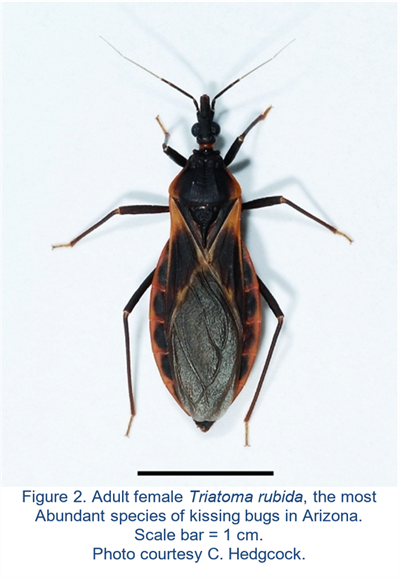
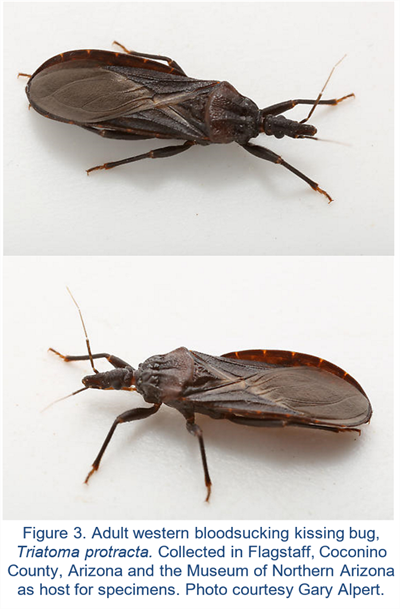
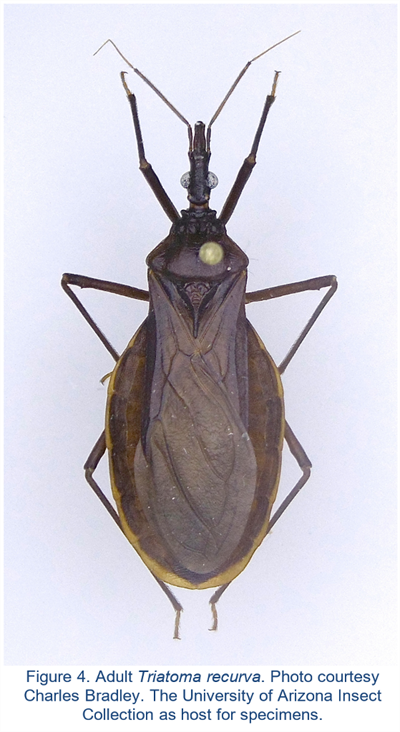
Biology and life history
Kissing bugs usually live outdoors and are often associated with the nests of Neotoma woodrat species (also called pack rats) and other wildlife. However, they can also be associated with domesticated animals, and often found in the bedding of outdoor doghouses and chicken coops.
Adults fly well and are attracted to lights after dark. In suburban and rural Arizona, kissing bugs are often attracted to porch lights. At dawn, they may seek a way to avoid sunlight and heat, and may enter a residence through a doorway gap, or cracks around window screens. They also enter homes by moving up from crawlspaces beneath flooring, or hitchhike in on pets. Once inside, they move toward areas of low light intensity, hiding in and under furniture (between mattresses is a favorite hiding place) and in closets during the daytime hours. Kissing bugs are most commonly encountered during their dispersal season, May through July, as adult kissing bugs fly towards homes attracted by lighting (Wood 1950, Ekkens 1981). Some species actively seek out humans and domestic animals to feed on. They are attracted to the gases we exhale, skin odors, and to the warmth of our bodies. Feeding occurs mainly at night, after which they tend to move away from the host. Engorged bugs are often found amongst bedding and drapes close to the bed in the morning.
The kissing bug life cycle begins with the spring or summer nighttime dispersal flight of adults from rodent burrows and dens. Eggs are laid in rodent nests in summer or early fall hatching in three to five weeks. Nymphs pass through five immature stages before turning into mature adults (Figure 5), and each stage requires a full blood meal to develop to the next stage.
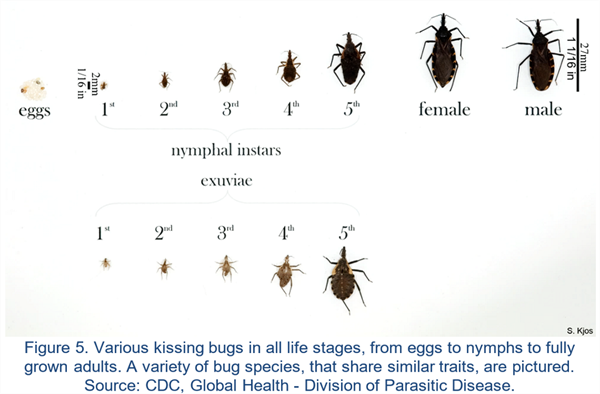
Blood is taken rapidly with feeding lasting 10 to 30 minutes. Fully engorged bugs can take one to five times their weight in blood, and the bugs will feed about every one to two weeks when hosts are available, and temperatures are warm. Adults live into mid- to late autumn. Kissing bugs overwinter as developing nymphs and molt into adults in spring.
Females can lay up to several hundred eggs over their lifespan depending upon conditions. Active dispersal is achieved by flight in adults, usually around dusk and early evening. Immature kissing bugs cannot fly but crawl to find a blood source.
Kissing bug bites and health concerns
In parts of southern and central South America, kissing bugs are the primary vectors of the parasite Trypanosoma cruzi that causes Chagas disease. Chagas is a severe, often chronic, and sometimes lethal disease. Unlike mosquito and tick vectored pathogens, the kissing bug bite does not transmit the parasite. The T. cruzi protozoan is transmitted in the kissing bug feces, which may be scratched into the bite wound, ingested, or accidentally rubbed by the host into moist tissues around the eyes, nose, and mouth.
Incidence of Chagas disease is low in the U.S., even though many species of kissing bugs carry T. cruzi in their gut. Researchers attribute the low incidence of Chagas disease in the continental U.S. to poor efficacy of protozoan transmission by the bugs, infrequent human contact, and poor ability of the bugs to permanently colonize homes. Studies (Reisenman et al. 2010) have shown that over 40% of the kissing bugs around Tucson, Arizona carry the parasite, but it is very rare for these bugs to transmit the disease to people.
Evidence of Arizona residents acquiring T. cruzi from Arizona kissing bugs (called autochthonous transmission) is rare (Beatty et al. 2018). In fact, transmission of T. cruzi within the continental U.S. is rare with 28 autochthonous infections documented from 1955 to 2015 (Montgomery et al. 2016, Turabelidze et al. 2020). However, overall risk in the U.S. is undefined and reporting suspected cases will aid surveillance efforts. Chagas cases have been increasing in the U.S., Canada, some European, and Western Pacific countries. This could be due in part to increased population mobility between Latin America where the disease is endemic, and the rest of the world.
The biggest health risk kissing bugs pose is one of severe allergic reaction. Some people develop a severe or life-threatening allergy to them after multiple bites. This makes it very important to avoid additional bites.
Call 911 if you have symptoms of severe allergic reaction.
2. Bug bite and possible allergic reactions (not parasite infection related)
Kissing bug bites usually occur at night, and may be single or grouped on the face, neck, arms, legs, and sometimes on the chest or other body parts. Bites are initially painless because the insect saliva contains an anesthetic, but might soon itch, swell, and cause a substantial welt that can last for several days. More severe reactions range from huge, painful welts to allergic reactions, that may become severe generating difficult breathing, low blood pressure, and rapid heart rates due to anaphylaxis.
Kissing bug bites can be confused with bites from other pests such as mosquitoes or bed bugs because the reactions can look similar.
Though the bites are generally painless, they can cause intense itching and tenderness at the bite site, which can become swollen and reddish to purple. The irritation may last one to two weeks, but sensitive individuals may experience more severe or prolonged reactions. With multiple subsequent bites, anaphylaxis may occur and may be potentially life threatening. Individuals who experience an allergic reaction should seek immediate medical attention. Who would suspect that an insect with a nickname of “kissing bug” could cause life threating allergic reactions (anaphylaxis) in sensitive individuals!?!
If you are bitten by a kissing bug, you should clean the bite site with soap and water. Oral antihistamines like diphenhydramine (e.g., Benadryl), topically applied 3-4% ammonia solution, and bathing in Epsom salts solution may help control itching. Severe reactions require medical treatment. Bites cannot be identified in the absence of an insect. If you find the bug, scoop the specimen up and put it in a container to take with you when seeking medical attention. Emergency allergy kits often are prescribed for patients who suffer severe reactions to use in case of future bites.
Chagas disease testing recommendations
In general, finding a kissing bug in your home or being bitten by one does not necessitate you undergoing tested for Trypanosoma cruzi. As we have mentioned, in the U.S. it is rare for the kissing bugs to transmit the parasite to people. However, visit your healthcare provider if symptoms develop. Testing for T. cruzi is commercially available so you can discuss this with your medical care provider.
Testing might also be indicated in other rare instances, such as if you test positive for T. cruzi during blood screening or if you have lived in countries outside the U.S., where Chagas disease is endemic (Mexico, Central and South America).
If your test results come back positive, a second test is indicated to confirm the infection. Your doctor can contact your local health department to arrange the test, which is performed by the Centers for Disease Control and Prevention (CDC). Starting in 2021, CDC is also offering kissing bugs testing, for more information see box below or contact your local health department.
CDC is offering Trypanosoma cruzi testing of kissing bugs that come in contact with humans. They offer identification via submission of a picture and testing for bugs identified as triatomine species. Please contact your state health department for instructions.
Arizona residents can email vbzd@azdhs.gov for approval with the following information:
If approved, the triatomine bug can be sent to the Arizona State Public Health Lab (using the Environmental Submission Form) which will forward it to CDC. Approximate turnaround time for testing is 3 weeks.
Pest-proofing your home is the best preventative measure against kissing bug bites
An attempt should be made to reduce the number of kissing bugs present in and around the home.
For more information, please read:
Li, S., Gouge, D.H., Nair, S., Fournier, A. and Hall, W.E. 2019. Arizona Kissing Bugs. University of Arizona Cooperative Extension. AZ1787. https://extension.arizona.edu/sites/extension.arizona.edu/files/pubs/az1787-2019.pdf
Gouge, D.H., Nair, S., Li, S. and Stock, T. 2015. Pest-proofing your home. University of Arizona Cooperative Extension. AZ1677. http://extension.arizona.edu/sites/extension.arizona.edu/files/pubs/az1677-2015.pdf
References
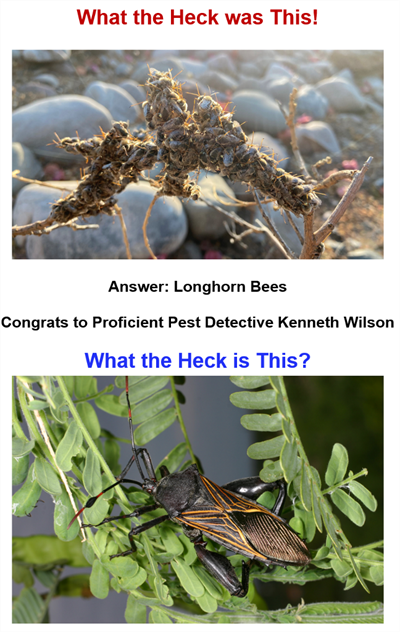
If you know what these are email the answer to Dawn at dhgouge@email.arizona.edu. You will not win anything if you are correct, but you will be listed as a “Proficient Pest Detective” in the next newsletter issue.
Open now for on-demand CEs. To register contact Dr. Lucy Li lucyli@email.arizona.edu
The Vector Preparedness Virtual Workshop is a great opportunity for anyone with an interest in learning information on mosquito ID, surveillance, management, and insecticide resistance in public health pests.
Arizona certified structural pesticide applicators can earn 4 CEUs from the AZ Department of Agriculture’s Pest Management Division (PMD) after completing the entire workshop. This course will be effective through August 30, 2021.
Check out upcoming Integrated Pest Management Webinars at https://www.epa.gov/managing-pests-schools/upcoming-integrated-pest-management-webinars. For more information about the EPA Schools program: http://www.epa.gov/schools/.
To view all our previous newsletters, visit: https://acis.cals.arizona.edu/community-ipm/home-and-school-ipm-newsletters.
This material is in part funded by the National Institute of Food and Agriculture, U.S. Department of Agriculture, under award number 2017-70006-27145 that provides Extension IPM funding to the University of Arizona. Information regarding this document is within the guidelines of the Border 2020 Program funded by the U.S. Environmental Agency (EPA) and administered by NADB. Additional support is provided by the U.A. – Arizona Pest Management Center.